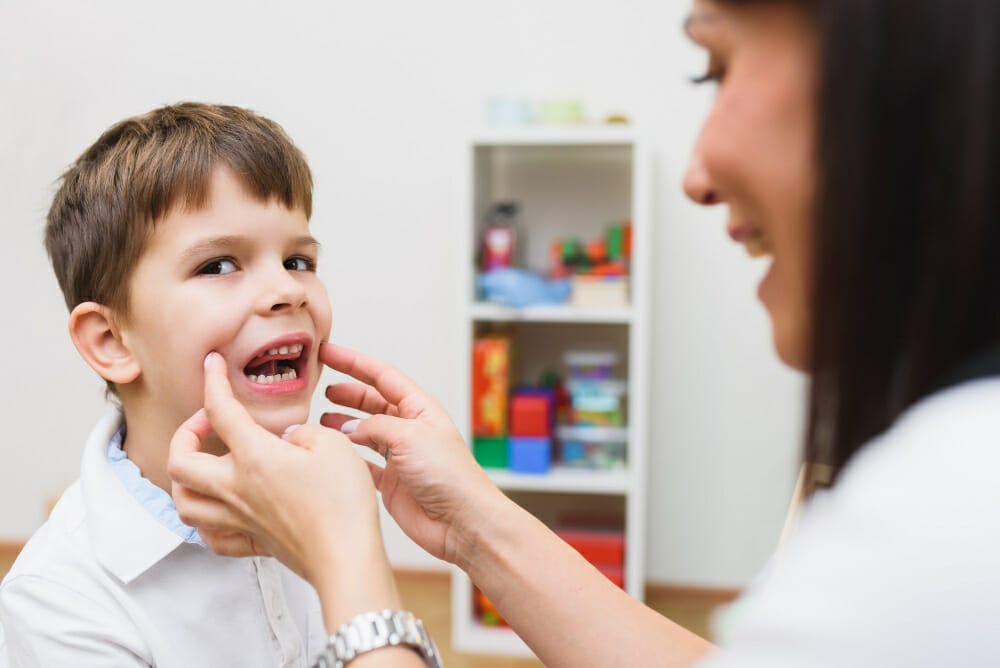As speech-language pathologists, we provide articulation and swallowing services to children and adults with a variety of medical and developmental etiologies. According to ASHA, Orofacial Myofunctional Disorders (OMDs) are patterns involving oral and orofacial musculature that adversely affect the normal growth, development, or function of orofacial structures. OMDs are considered multifactorial disorders that may be due to learned behaviors, physical variables, and genetic factors.
The most common signs or symptoms of the presence of an orofacial myofunctional disorder include open mouth posture at rest, restricted lingual frenulum, tongue thrusting, chronic mouth breathing, dental abnormalities affecting bite, distorted or errored speech productions of /s,z, t, d, l, n, ʧ, ʤ, ʃ, ʓ/, and significant drooling past the age of 2 years. Breath support and daily habits are both significant features to consider when discussing OMDs. Airway incompetency seems to have a large effect on oral closure and thus tongue placement at rest, which can disrupt tongue placement for speech accuracy as well as developing appropriate swallow patterns.
Airway incompetence can include obstructed nasal passages, such as structural concerns of enlarged tonsils or adenoids. Poor habits, such as the chronic use of pacifiers past the age of 3, prolonged use of sippy cups, thumb sucking, and clenching/grinding of the teeth also adversely affect lip closure, tongue posture, and dentition development. In turn, reiterating how physical structures, as well as learned behaviors, can impact orofacial development.
When a speech-language pathologist provides intervention for children with OMDs, it should be as a member of a collaborative team in order to ensure all areas of concern attributing to the presence of an OMD are being addressed. These collaborative teams can include the following disciplines: Dental Hygienist, Speech-Language Pathologist, Dentist, Physical Therapist, and Occupational Therapist who are specifically trained in orofacial myology.
The International Association of Orofacial Myology, IAOM, is the only organization in the United States that offers a trademarked certification in Orofacial Myology. In order to become a member, you have to complete a minimum of 28 hours, beyond your degree, in specific orofacial myology training. Whether an SLP chooses to become a certified orofacial myologist or not, it is important for SLPs to understand how the presence of OMDs will affect their patient’s progress with treatment and shape their treatment plan to lead to the highest level of progress possible.
The therapeutic focus for OMDs should target increasing the strength and function of orofacial musculature, increasing speech accuracy, breathing exercises, and addressing any postural problems. Addressing these areas of concern can lead to increased accuracy with speech patterns as well as correcting and developing appropriate chewing and swallowing habits.
A cornerstone of myofunctional therapy is training the mouth to be at rest in a natural, correct position. Improving appropriate tongue and lip posture not only increases speech accuracy but also promotes normal patterns of dental eruption and alignment and appropriate jaw functioning. Research has shown that a therapeutic focus on oral postures in conjunction with articulation training led to better increases in speech intelligibility than articulation drill therapy alone.
Speech and swallowing therapy is appropriate at all ages of development, depending on the needs and areas of concern. Specific orofacial myofunctional therapy is recommended at various ages of development. Typically, evaluations by COMs, Certified Orofacial Myologists, begin at the age of 4 years old, to determine factors contributing to OMDs and develop an intervention plan. Children can begin therapy to target harmful sucking habits at 5 years of age and begin to truly participate in an orofacial myofunctional therapy program around the age of 7 years old.
Understanding orofacial myology is an important aspect of a speech-language pathologists’ scope of practice and participating in educational training in this area will help a clinician gain useful tools for articulation therapy as well as feeding and swallowing therapy. Should you have any questions about OMDs and the SLP’s role, you can reach me via email [email protected].
Citations:
“What Is Myo.” TalkTools. TalkTools. Accessed October 22, 2021. https://talktools.com/pages/omt-orofacial-myofunctionaltherapy101.
“What Are Orofacial Myofunctional Disorders (OMDs).” IAOM. International Association of Orofacial Myology, September 25, 2020. https://www.iaom.com/faq/.
“Orofacial Myofunctional Disorders.” American Speech-Language-Hearing Association. American Speech-Language-Hearing Association. Accessed October 22, 2021. https://www.asha.org/practice-portal/clinical-topics/orofacial-myofunctional-disorders/.
Ray, J. (2003). Effects of orofacial myofunctional therapy on speech intelligibility in individuals with persistent articulatory impairments. International Journal of Orofacial Myology, 29(1), 5-14.

